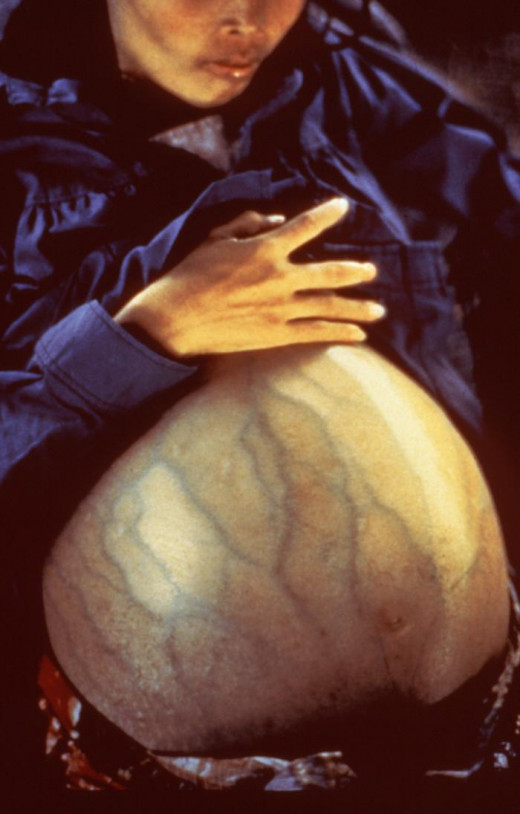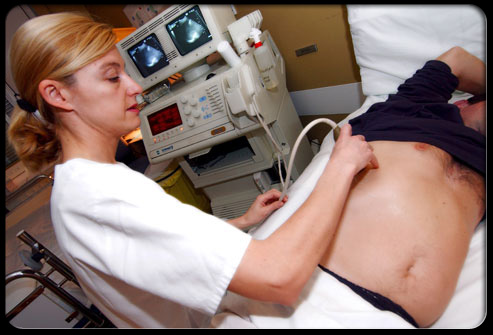Viral Hepatitis: The Heal Significance Of Its Complications, Chronic Hepatitis, Diagnosis And Prognosis
Ascites In Carcinoma Hepatitis

Diagnosis And Prognosis Of Hepatitis
Differential diagnosis: Drug-induced hepatitis, intrahepatic cholestasis due to other causes and cholangitis present with jaundice and these have to be differentiated. Though hepatic amoebiasis is not generally associated with jaundice, in a few cases, it may create problems when mild or moderate jaundice occurs. Hepatic amoebiasis presents with tender hepatomegaly, moderate leucocytosis, no impairment of hepatocellular function and recovery with antiamoebic drugs.
Prognosis: Viral hepatitis is a benign disorder which recovers uneventfully in most of the cases. In children, the disease runs a milder course whereas in the elderly patients, complications occur. Fulminant hepatitis carriers a grave prognosis. During pregnancy, the disease carries a higher risk of mortality and morbidity, especially in the malnourished subjects.
Liver Scan On A Hepatitis B Patient

Infectious Diseases
Complications And Sequelae Of Viral Hepatitis
Complications occur in a small proportion of cases whereas the vast majority of cases recover uneventfully.
Relapse: About 15% of patients may get relapse after initial clearance of the jaundice. Premature resumption of physical activity favours relapse. With proper management, this also subsides completely.
Prolonged cholestasis: Cholestasis may persist due to the development of intrahepatic obstruction. With rest and supportive measures, these patients usually recover completely within weeks or months.
Fulminant hepatitis: This is a serious complication occurring in 1 to 2% of patients, more os in type B hepatitis. Hepatic function deteriorates rapidly with the onset of acute hepatocellular failure within 8 weeks of onset. The liver shrinks progressively. The condition is fatal in 80% of patients, irrespective of the treatment. Death is due to brainstem damage, gastrointestinal hemorrhage, infections or renal failure. The overall mortality is 2% in HBV infections and 10% or more in post-transfusion hepatitis, as the infecting dose is high in the latter.
Chronic Hepatitis
This is defined as continuing inflammation of the liver persisting for more than six months. Type B hepatitis (not HAV) is one of the causes of chronic hepatitis. This may take the form of chronic persistent hepatitis which is benign and self-limiting or chronic active hepatitis which is more sinister and often ends up in hepatic failure or cirrhosis.
Cirrhosis: Rarely, hepatitis B can progress to cirrhosis directly. More often it does so, through a stage of chronic active hepatitis.
Hepatocellular carcinoma: The virus of hepatitis B is oncogenic. Persistence of the virus in the system for 25 years or more predisposes to carcinoma. The risk of developing hepatocellular carcinoma is high in HBV carriers. The incidence of cancer correlates directly with the HBV carrier rate. In areas where HBV carrier rate is very high (15%), the mean age for carcinoma is 25 years, since a good number of subjects get infected perinatally. In areas where the HBV carrier rate is low (1% or less), the mean age for cancer is 50 years or more, since the main source of infection is parenteral or sexual route. Malignancy may follow hepatitis directly or through a phase of cirrhosis.
Post- hepatitis syndrome: Sometimes, symptoms of illhealth persist for many months after apparent recovery. The liver may remain slightly enlarged with evidence of mild or moderate dysfunction. Such persons generally show anxiety and loss of morale which aggravate the disability. If followed up, many recover- only reassurance is needed.
Extrahepatic Manifestations: Patients with HBV infection have circulating immune complexes, which lead to the development of serum sickness-like picture early in the disease. Other extra-hepatic manifestations include glomerulo-nephritis, polyarteritis nodosa, essential mixed cryoglobulinemia, papules acrodermatitis and polymyositis.
Finally, aplastic anemia may follow HAV infection rarely.
© 2014 Funom Theophilus Makama









